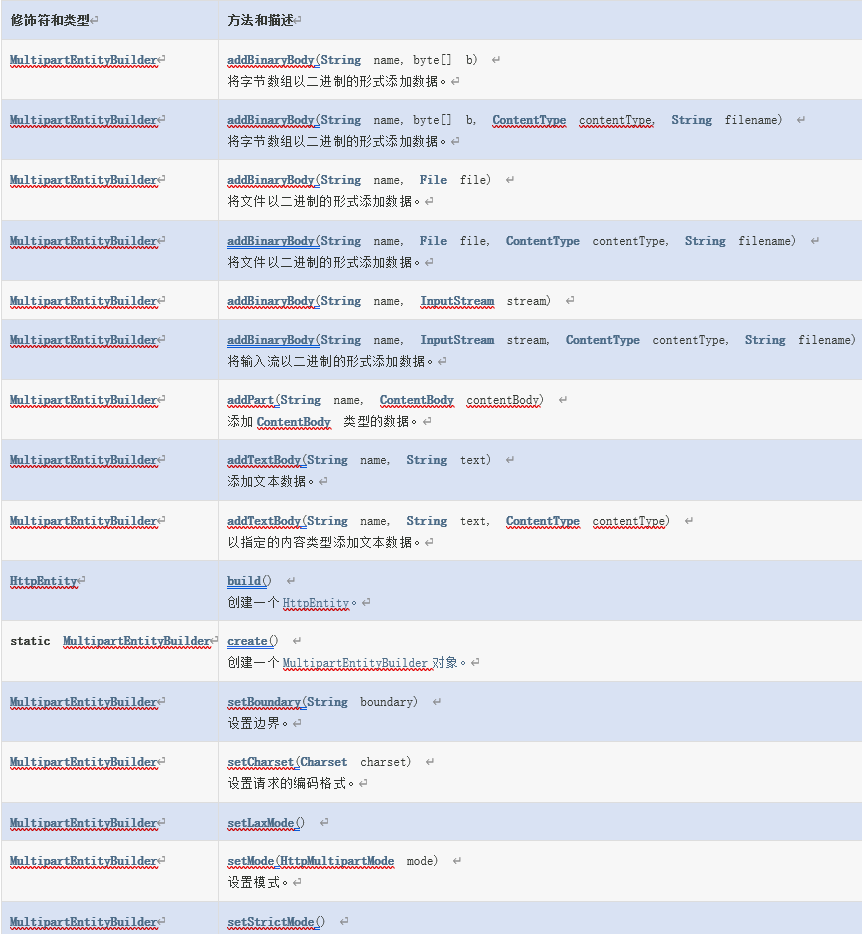注意:在HttpClient4.3之后,原来的上传文件方法MultipartEntity已经不建议使用,现替换成新的httpmime下面的MultipartEntityBuilder。
需要添加httpclient-4.5.jar、httpmime-4.5.jar两个包
maven添加:
|
1 2 3 4 5 6 7 8 9 10 |
<dependency> <groupId>org.apache.httpcomponents</groupId> <artifactId>httpmime</artifactId> <version>4.5</version> </dependency> <dependency> <groupId>org.apache.httpcomponents</groupId> <artifactId>httpclient</artifactId> <version>4.5</version> </dependency> |
下面我们对比一下MultipartEntity和MultipartEntityBuilder的使用区别:
MultipartEntityBuilder:
|
1 2 3 4 5 6 7 8 9 10 11 12 13 14 15 16 17 |
//传入参数可以为file或者filePath,在此处做转换 File file = new File(filePath); CloseableHttpClient httpClient = HttpClients.createDefault(); CloseableHttpResponse httpResponse = null; HttpPost httppost = new HttpPost(url); MultipartEntityBuilder builder = MultipartEntityBuilder.create(); //设置浏览器兼容模式 builder.setMode(HttpMultipartMode.BROWSER_COMPATIBLE); //设置请求的编码格式 builder.setCharset(Consts.UTF_8); builder.setContentType(ContentType.MULTIPART_FORM_DATA); //添加文件 builder.addBinaryBody("file", file); HttpEntity reqEntity = builder.build(); httppost.setEntity(reqEntity); httpResponse = httpClient.execute(httppost); |
MultipartEntity:
|
1 2 3 4 5 6 7 8 9 10 |
//传入参数可以为file或者filePath,在此处做转换 File file = new File(filePath); CloseableHttpClient httpClient = HttpClients.createDefault(); CloseableHttpResponse httpResponse = null; HttpPost httppost = new HttpPost(url); FileBody filebody = new FileBody(file); MultipartEntity entity = new MultipartEntity(HttpMultipartMode.BROWSER_COMPATIBLE, null, Charset.forName("UTF-8")); entity.addPart("file", filebody); httppost.setEntity(entity); |
直接上替换后的测试代码:
|
1 2 3 4 5 6 7 8 9 10 11 12 13 14 15 16 17 18 19 20 21 22 23 24 25 26 27 28 29 30 31 32 33 34 35 36 37 38 39 40 41 42 43 44 45 46 47 48 49 50 51 52 53 54 55 56 57 58 59 60 61 62 63 64 65 66 67 68 69 70 71 72 73 74 75 76 77 78 79 80 81 82 83 84 85 86 87 88 89 90 91 92 93 94 95 |
package com.test.util; import net.sf.json.JSONObject; import org.apache.commons.lang.StringUtils; import org.apache.http.Consts; import org.apache.http.HttpEntity; import org.apache.http.HttpStatus; import org.apache.http.client.ClientProtocolException; import org.apache.http.client.methods.CloseableHttpResponse; import org.apache.http.client.methods.HttpPost; import org.apache.http.entity.ContentType; import org.apache.http.entity.mime.HttpMultipartMode; import org.apache.http.entity.mime.MultipartEntityBuilder; import org.apache.http.impl.client.CloseableHttpClient; import org.apache.http.impl.client.HttpClients; import org.apache.http.util.EntityUtils; import java.io.*; import java.net.HttpURLConnection; import java.net.URL; import java.util.Iterator; import java.util.Map; public class HttpPostUploadUtil { /** * @param args */ public static void main(String[] args) { String filePath = "D:\\Test\\0.jpg"; String url = "http://127.0.0.1:8080/FastFds"; //调用上传方法 String backInfo = uploadPost(url, filePath); if(StringUtils.isNotBlank(backInfo)){ //转json数据 JSONObject json = JSONObject.fromObject(backInfo); if(!json.isEmpty()){ //数据处理 String value = json.getString("test"); System.out.println(value); } } } /** * 上传图片/文件 * @param url * @param filePath * @return String 用于转json或者其他信息 */ public static String uploadPost(String url, String filePath) { String requestJson = ""; //传入参数可以为file或者filePath,在此处做转换 File file = new File(filePath); CloseableHttpClient httpClient = HttpClients.createDefault(); CloseableHttpResponse httpResponse = null; try { HttpPost httppost = new HttpPost(url); MultipartEntityBuilder builder = MultipartEntityBuilder.create(); //设置浏览器兼容模式 builder.setMode(HttpMultipartMode.BROWSER_COMPATIBLE); //设置请求的编码格式 builder.setCharset(Consts.UTF_8); builder.setContentType(ContentType.MULTIPART_FORM_DATA); //添加文件 builder.addBinaryBody("file", file); HttpEntity reqEntity = builder.build(); httppost.setEntity(reqEntity); httpResponse = httpClient.execute(httppost); int backCode = httpResponse.getStatusLine().getStatusCode(); if(backCode == HttpStatus.SC_OK){ HttpEntity httpEntity = httpResponse.getEntity(); byte[] json= EntityUtils.toByteArray(httpEntity); requestJson = new String(json, "UTF-8"); //关闭流 EntityUtils.consume(httpEntity); return requestJson; } } catch (ClientProtocolException e) { e.printStackTrace(); } catch (IOException e) { e.printStackTrace(); } finally { //释放资源 try { httpClient.close(); httpResponse.close(); } catch (IOException e) { e.printStackTrace(); } } return null; } } |
主要方法说明:
主要方法说明:
addBinaryBody、addPart、addTextBody方法用于添加要上传的数据,从上面的表格中可以发现用于添加数据的方法,都是key-value类型。所以在服务器端我们可以通过request.getPart("keyname")方式获取对应key的数据。也可以通过request.getParts()方式获取客户端通过以上三种方法提交所有数据。
1.通过addBinaryBody方法直接可以添加File、InputStream、byte[]类型的数据。
2.通过addPart方法只能添加ContentBody类型的数据,在org.apache.http.entity.mime.content包中已经提供了String、File以及InputStream对应的ContentBody类型的子类,如FileBody、InputStreamBody、StringBody,通过这些类我们可以将String、File以及InputStream类型的数据转换成ContentBody类型的数据。
3.通过addTextBody方法我们可以很方便的添加文本数据。、
MultipartEntityBuilder的API:
